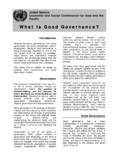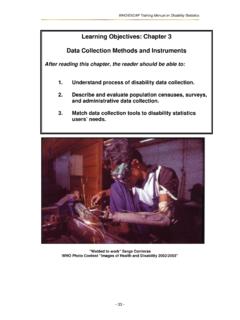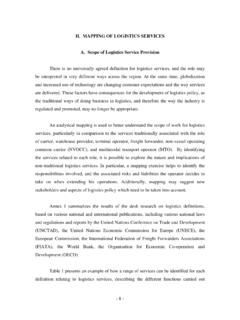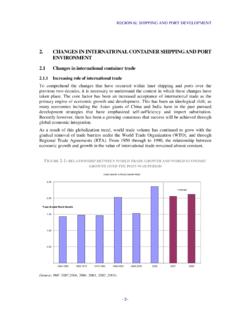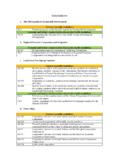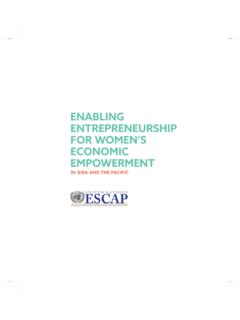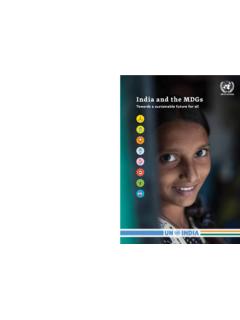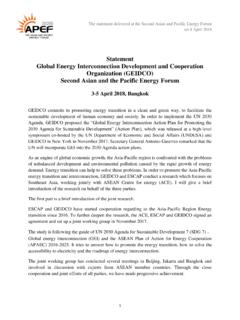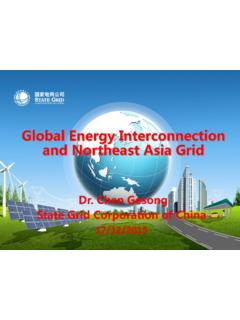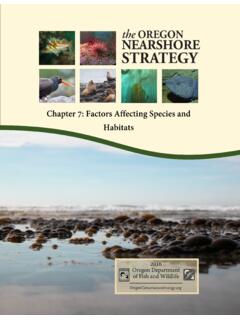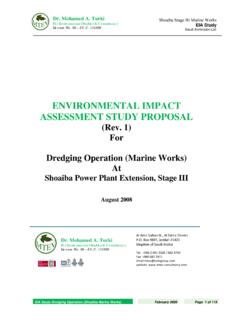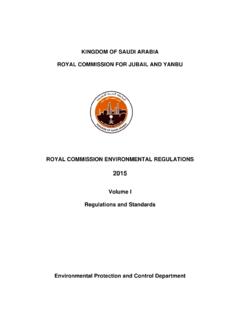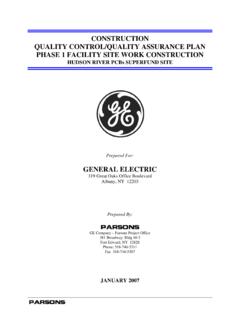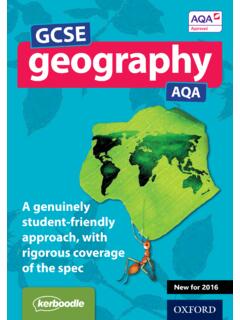Transcription of 2 ENVIRONMENTAL IMPACTS OF PORT DEVELOPMENT
1 2 ENVIRONMENTAL IMPACTS OF PORT DEVELOPMENTC hecklists of adverse effects of port DEVELOPMENT for EIA have been compiled by severalorganizations including the World Bank, the Asian DEVELOPMENT Bank and the InternationalAssociation of Ports and Harbors. Based on a review of these checklists, the relationshipbetween factors in port DEVELOPMENT and their IMPACTS on the environment has been outlinedin table sources of these adverse effects can be categorized into three types: (a) locationof port; (b) construction; and (c) port operation, including ship traffic and discharges, cargohandling and storage, and land transport. Location of port connotes the existence ofstructures or landfills, and the position of the DEVELOPMENT site. Construction impliesconstruction activities in the sea and on land, dredging, disposal of dredged materials, andtransport of construction materials. Port operation includes ship-related factors such asvessel traffic, ship discharges and emissions, spills and leakage from ships; and cargo-relatedfactors such as cargo handling and storage, handling equipment, hazardous materials,waterfront industry discharges, and land transport to and from the facets to be considered in relation to port DEVELOPMENT are categorizedinto nine groups: (a) water quality; (b) coastal hydrology; (c) bottom contamination; (d) marineand coastal ecology; (e) air quality; (f) noise and vibration; (g) waste management ; (h) visualquality; and (i) socio-cultural quality includes five elements: (a) general features such as temperature, salinity,pH, colour, transparency, oil and grease, and organic material concentration measured bytotal organic carbon (TOG), chemical oxygen demand (GOD) or biochemical oxygen demand(BOD); (b) turbidity measured by suspended solids (88).
2 (c) eutrophication-related factorsmeasured by dissolved oxygen (DO), nitrogen (N) and phosphorus (P); (d) harmful or toxicsubstances including heavy metals such as mercury, cadmium, lead, and pesticides; and (e)sanitation-related factors determined by measuring the amount of coliform hydrology cited here includes factors concerning currents, tidal flow, littoral drifts,beach erosion, water drainage, sediment deposition, groundwater flow, and other physicalphenomena in the shore contamination encompasses many kinds of contamination of bottom sedimentsby toxic or harmful substances, oils, oily mixtures and other hazardous of bottom sediments are often measured by the size of sediment particles, pH,colour, smell, oil and grease, organic materials, and concentration of organic nitrogen,phosphorus, sulphide, and toxic substances such as heavy metals and pesticides includingtoxic components of antifouling and coastal ecology includes aquatic fauna and flora composed of a largenumber of species of bacteria, phytoplankton, zooplankton, benthonic organisms, coral,seaweed, shellfish, fish and other aquatic biota.
3 Terrestrial flora such as mangroves andwetlands. Loss of bottom habitat and fishery resources are also significant problems includedin this quality consists of two main elements: (a) soot and dust, measured by suspendedparticulate matter (SPM), which originate from dry bulk cargo handling and storage,construction work on land, and road traffic; and (b) concentration of sulfur dioxide (S02)'nitrogen dioxide (N02), carbon monoxide (CO), and hydrocarbons (HC) emitted from ships,6vehicles and various equipment used for port activities. Harmful substances and odour arealso elements to be considered in this and vibration generated by road traffic, cargo operations, ship traffic and other portactivities also cause nuisances to local management relates to all kinds of wastes, both liquid and solid, likely to bedisposed of in the port area. These wastes include dredged materials, garbage and oilymixtures discharged from ships, wastes from cargo operations, and all types of dischargesfrom municipal and waterfront industry quality refers to the aesthetic value of the landscape, the view of port facilities,the nuisance of bright lights used for night operations in a port, and other visual IMPACTS includes all kinds of influence on the local community and people'slife style such as relocation of villages, industrialization, population growth nearby, and theformation of following section reviews the potential IMPACTS of port activities on each facet of theenvironment and possible measures against potential adverse effects.
4 Relations betweenimpact sources and various part of the environment are summarized in table Major IMPACTS of port DEVELOPMENT project on the environmentSourceLocationof portConstructionanddredgingPort operationShip trafficanddischarges(C)Cargooperationsan d waterfrontindustry(0)Facet of theEnvironment(A)(B)Water quality(1)A181C101 CoastalhydrologyA282(2)A38303 Bottomcontamination (3)Marine/coastalecologyA484C404(4)Air quality(5)85C505 Noise andvibration8606(6)B7C707 Wastemanagement(7)Visual qualityA8D8(8)Socia-culturalimpactA9C909 (9) IMPACTS OF LOCATION OF Potential IMPACTS on water quality (A1 of table )Breakwaters and landfills may change current patterns and cause stagnation of waterbehind the structures. If municipal or industrial effluent flows into a port, stagnant port watermay deteriorate through a dramatic increase of phytoplankton and a decrease of dissolvedoxygen, resulting from eutrophication of water, caused by effluents containing nutrient salts(chemical compounds including Nand P).
5 Anaerobic water leads to the generation ofhydrogen sulphide (H2S) and can be identified by its odour. It has serious effects onorganisms. Municipal sewage also brings coliform bacteria into the port and may causeunacceptable contamination of the against adverse effectsCareful site selection and port design should be carried out, focusing on the possibilityof water stagnation. If the basic pollution level is critically high, a sewage treatment syst~mshould be planned as part of the environment management of the area. Regulations ondischarges of effluents into water and provision of sanitary treatment facilities areindispensable for reducing pollutants from hinterlands. In a polluted bay or port, it could beeffective to dredge or cover contaminated bottom sediment capping to reduce the flux ofpollutants from the sediment to the Potential IMPACTS on coastal hydrology (A2 of table )The location of a port may cause changes in current patterns and littoral drifts due toalteration of wave refraction, diffraction and reflection.
6 The change of littoral drift may lead toerosion or accretion in shore zones. Altered currents or reflected waves may endanger smallships maneuvering near structures. The creation of a port may cause changes in river flowand waterfront against adverse effectsCareful site selection and port design could minimize changes in current patterns andother coastal hydrology. Model experiments or computer simulations of these changes areuseful in developing an appropriate design. Typical measures against beach erosion areconstruction of sea walls, jetties, offshore breakwaters, and periodical beach Potential IMPACTS on bottom contamination (A3 of table )The location of a port may accelerate sediment deposition in stagnant water behindstructures and cause contamination of the sea bottom. Sediment deposition covers bottombiota and physical habitat. Pile structures shade the bottom and affect habitat. Eutrophicationof water induces sedimentation of dead plankton and changes chemical characteristics ofbottom sediments, resulting in an increase of organic matter, hydrogen sulphide, andmobilization of harmful against adverse effectsRemoval of contaminated sediments, capping, as well as other measures mentioned insubsection could be effective measures against adverse effects on water Potential IMPACTS on marine/coastal ecology (A4 of table )The location of a port affects aquatic fauna and flora through changes of water quality,coastal hydrology and bottom contamination.
7 Land reclamation from the sea destroys bottomhabitat and displaces fishery resources. Terrestrial fauna and flora may also be altered by thelocation of a of bottom biota is usually linked to a reduction of fishery resources, andoccasionally to an increase of undesirable species. Deterioration of water quality usually givesrise to changes in aquatic biota: a decrease in the number of species; and an increase in thequantity of one or two specific species. Further deterioration may lead to the destruction ofall kinds of aquatic of plants in a shore zone within enclosed water may degrade its aerationcapability and worsen water pollution. Mangroves in wetlands play an important role inproviding habitat for terrestrial and aquatic biota and indirectly recovering water against adverse effectsAdverse effects on marine and coastal ecology usually result from: deterioration of waterand air quality; current pattern changes; bottom contamination; physical loss of water area;and changes in natural land habitat.
8 Measures mentioned in subsections and areeffective for mitigating changes in aquatic and terrestrial habitat. Careful survey of theecological characteristics of a project area is indispensable if the welfare of endangered andfragile species is to be considered and disruption of their spawning seasons and areas andmigration is to be minimized. Planting of green plants around a port may be an effectivemeans to mitigate adverse effects on terrestrial Potential IMPACTS on visual quality (A8 of table )The visual quality of a project area is affected by the creation of a port, port facilities,lighting, and other optical disturbances. The landscape may be changed into an artificialscene of industrialization. Some port facilities may give an unpleasant impression to against adverse effectsThe design of port should cause it to blend with its surroundings. Special attention to thecolors of port facilities and landmarks helps improve port scenery.
9 A green belt zone arounda port may block an unpleasant view of the port and be a more pleasant Socio-cultural IMPACTS (A9 of table )Building or expanding a port often requires relocation of the local community, sometimescausing ethnic, cultural, tribal, or religious conflicts with local people. Industrialization andmodernization may change the cultural traditions of the local against adverse effectsAn appropriate resettlement plan could minimize the disturbance to the local communityand ensure smooth transition to industrialization. Survey of archaeological heritage sitesshould be undertaken well in advance and a preservation plan included in any portdevelopment plan. During the evaluation stage of a DEVELOPMENT project, following informationshould be provided:10(a)Distribution of population around the project area:Initial population distribution, age composition, households, slums, socialsolidarity, public peace and order, infrastructure(b)Race composition:Majority and minority groups, cultural gaps, basic resources for life, racialconflicts(c)Removal and resettlement of local people:Removal population, conservation of community, condition of resettlement,opinions on removal and resettlement(d)Cultural heritage:Location of heritage, importance of heritage, legislation on preservation,possibility of IMPACTS OF Potential IMPACTS on water quality (81 of table )Pile driving, deposition of rubble, dredging, sand compaction and other construction workin water cause resuspension of sediments and turbid water.
10 Resuspension of sediments inwater leads to an increase in the level of suspended solids (88) and in the concentration oforganic matter, possibly to toxic or harmful levels. It also reduces sunlight vessels are a possible cause of oil spills, garbage discharge, and leakage of othersubstances into water. Diffusion from concrete work in water and overflows from landfills maybe possible sources of water against adverse effectsThe adverse effects of construction work could be minimized by appropriate selectionof equipment in pile driving or dredging, proper use of silt curtains, careful planning of settlingponds and overflow weirs for landfills, and suitable transport of construction materials anddredged material. Proper disposal of dredged material plays a critical part in preserving theenvironment. Deposition in landfills may offset problems being caused by dumping at Potential IMPACTS on coastal hydrology (82 of table )The potential IMPACTS of construction on coastal hydrology are nearly the same as thepotential IMPACTS of the location of a port which are identified in subsection Dredgingmay cause changes in current patterns and flows as well as salt wedge intrusion into a rivermouth or littoral drifts in the shore zone.
